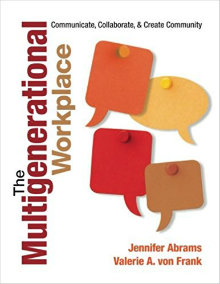Can Teacher Generations Learn to Collaborate?
The Multigenerational Workplace: Communicate, Collaborate, and Create Community
By Jennifer Abrams and Valerie A. von Frank
(Corwin, 2014 – Learn more)

Within each new generation of teachers come new ideas and fresh ways of thinking, acting and reacting – and these changes become even more pronounced with the fast pace of technological change. So how to multiple generations of teachers, working in the same building, ever get in sync?

Traditionalists, Baby Boomers, Gen Xers, and Millennials are all code names for the generations presently working in educational institutions. A generation is “an indefinable group that shares years, age, location, and significant life events at critical developmental stages.” (Tolbize, 2008)
I will be honest with you. At first glance, I wasn’t sure why this book was written. Someone who glances through the pages of this book might wonder why someone would need to explain how a 22-year old is different from a 67-year old (my age!). One of my first thoughts was…We all know that different generations tend to act in a particular way. So what? Can we really do anything to bridge the generational divide in school?
Then, as I continued to read the book, I was so grateful that I had the opportunity to find the answer. Being an official member of the Baby Boomer generation, I sometimes walk around with a quizzical look on my face. I can understand how teachers that are close to my age act and react, but I am sometimes confused as to how and why my younger colleagues are behaving in a particular way.
Authors Abrams and von Frank argue that we can all work in the same building, side by side, peacefully and collaboratively, with each group learning from the others with the best interests of the students in mind.
I believe it can take place in any and every school, but it isn’t always an easy thing to accomplish and sometimes can be very challenging. How do you motivate educators to share their knowledge and relate to each other in a noncompetitive practice? How do you go about changing a fixed mindset? (The answer – read this book!)
We all bring different things to the table
Understandably, we all come to the table with different values, thoughts, and beliefs which are built from prior experiences – whether from societal norms of the time, our family background, or even trends in teacher preparation.
How we act and react impacts not just the adults we work with, but also the children. Therefore, it is important that we understand what makes people “tick” and why. It is important because generational differences can be problematic and significant in an educational environment.
Teacher generation gaps can cause the following problems (p.2):
- Questions of fairness
- Lower morale
- Problems working in teams
- Decreased efficiency/lower productivity
- Communication snafus
- Increased turnover and hiring challenges
- Gaps in succession planning
Do any of the above sound familiar?
How the book is organized
The book is divided into two sections. The first section sets the stage for understanding by defining the different generations and characteristics of each, while noting what links them together. The authors help the reader make sense of how the generational differences influence the way colleagues work and collaborate with others, especially when a widening gap between the generations is present. Part One is a chance to explore and understand what a multigenerational workplace is.
Part Two of the book takes the definition and characteristics of each generation to the next level by providing strategies, exercises and resources for readers to use within their educational environment. It is a place where you learn how YOU can take action to deepen your understanding of the generations and become a change agent.
Listen, listen, listen
The statistics about multigenerational problems are shocking. In a 2010 study (BridgeWorks Generations Survey, Lancaster and Stillman) “one-third of respondents said they were offended at work by someone from another generation.” Pause for a moment and think about the amount of productive time and energy that has been wasted due to a lack of listening.
To be able to communicate, you need to listen first. This book helps you listen. The authors provide numerous relevant surveys, protocols, and interactive exercises for school leaders to implement with the staff. They can easily be used at a staff meeting, professional development day, inside team meetings, and across professional learning communities.
This is not a book for just today, but a book for the future, and I hope that the authors continue with an updated version of the book as time evolves. Generational gaps will always be present. “The generational gap according to Deal (2007, p. 1) is in large part the result of miscommunication and misunderstanding, flooded by common insecurities and the desire for clout – which includes control, power, authority and position.”
This book is indispensable to school leaders who may be facing generational differences among their staff. It’s not enough to think that “getting along” will come with time. School leaders need to make sure that as the workplace becomes more diverse, deliberate measures are instituted to help promote collaboration.
In The Multigenerational Workplace: Communicate, Collaborate, and Create Community, Abrams and von Frank provide proven strategies that can be applied immediately and have a positive impact on staff engagement and workplace morale. This book is a wonderful asset to administrators, school leaders, educators who want the best for their students and their staff.
Linda Biondi recently retired from her post as fourth grade teacher at Sharon Elementary School in Robbinsville, NJ. She’s has been the recipient of several educational grants, a Teacher Consultant with the National Writing Project, and a participant on the NJ Department of Education Teacher Advisory Panel and with ECET2 Celebrate Teaching. She hopes to continue her work in schools as a teacher mentor and trainer.


































